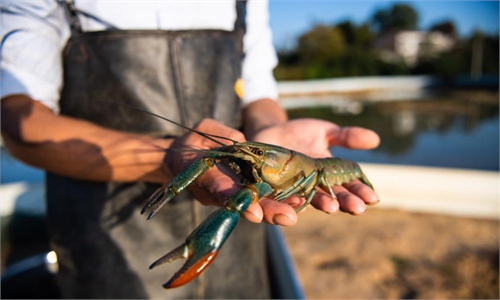
A female anchor of celebrity beauty in short video platform Douyin shares the delicious food with netizens while eating crayfish on June 6. The booming night market of Shanghai nightlife festival promoted the economy of eating show. Photo: IC
Brisk crayfish sales in June - boosted by nighttime viewing of the European Football Championship matches - have greatly improved the business of crayfish farmers from Central China's Hubei Province, further pushing the province's recovery following a robust first quarter, with a 60 percent annual growth.
E-commerce sales of crayfish, a popular snack food in China, soared 117 percent in June, media reports said, citing data. And this has helped crayfish farmers in Hubei recover from a disaster in sales last year due to the COVID-19 outbreak.
Last year, the outbreak of COVID-19 affected the sales of crayfish, a 22.79 billion yuan ($3.54 billion) industry. In an effort to boost sales and show solidarity to the then virus-stricken province, people from all over China bought Hubei crayfish, and celebrities and local officials took to the internet to advertise the product.
With the start of the Euro Cup, soccer fans are ordering snack food, and crayfish has enjoyed brisk business.
In Qianjiang, a Hubei city known for crayfish farming, a crayfish trading center with more than 20,000 crayfish farmers, sorting workers and other industry-related employees are reporting daily trade of over 1,500 tons, according to Chinese media reports.
An employee from Xiagu 360, an online center for crayfish trading in Qianjiang, said that recent statistics suggest that sales of living crayfish this year have climbed 20 percent compared with the same period last year. Livestreaming has helped boost sales by another 5 percent this year, said He Tao, manager of the platform's operations team. He noted that more than 10,000 daily orders have been made on the platform.
Brisk sales have brought crayfish farmers' joy.
Wang Hu, a crayfish farmer in Qianjiang, told the Global Times that crayfish sales have soared since Hubei successfully kept virus infections at bay last spring.
Chen Xiang, a resident of Chengdu, Southwest China's Sichuan Province, also bought Hubei crayfish last year.
As a soccer fan, Chen said "beer, crayfish and Euro Cup, these are what make a perfect summer." Chen said this time last summer, he was not in the mood to engage in any entertainment. "In the first half of last year I was in fear, fear of the pandemic and everything that might come with it. Now, not only am I eating crayfish and drinking beer, I even saw crowds at the stadiums mask-less. It's incredible."
The recovery of crayfish is just one facet of Hubei's recovery from the economic onslaught of the COVID-19. For the first five months of the year, the province's retail sales reached 773.61 billion yuan, increasing 40.4 percent year-on-year, according to the provincial statistical authority. Merchandise sales on the internet jumped 38 percent from the same period last year.
In January-May, Hubei's industrial output grew 45.9 percent and fixed-asset investment soared 121.4 percent year on year.
Deeply affected by the pandemic, Hubei is the last province in China to resume work and production, in May last year.
However, analysts said the province's recovery is in full throttle and what slows the province's recovery is downward pressure from external factors.
"Tourism, catering, transportation - sectors hit hard by the pandemic - are apparently returning to pre-virus growth levels," Dong Dengxin, director of the Finance and Securities Institute at the Wuhan University of Science and Technology, told the Global Times on Friday.
The surge in commodity and raw material prices have weighed on the province's industrial sectors, and a new wave of infections has swept across Southeast Asian countries - those countries have a close economic bond with China and the impact is also felt in Hubei.
"It is the external factors that are putting a strain on the province's economic recovery," Dong said.
Dong predicted Hubei's GDP growth will be 7-10 percent year.
As the first province in China hit by the COVID-19 outbreak, Hubei's GDP in the first quarter of 2021 rose 60 percent, recovering from a 40-percent plunge in the same period last year, according to official statistics released in April.
The provincial GDP increased 58.3 percent to reach 987.27 billion yuan ($151.4 billion) in the first quarter. The secondary sector expanded 88.9 percent year-on-year, while the services sector grew by 45.7 percent. The primary industry, which didn't grow at all last year, expanded 24.9 percent in the first quarter of this year.



